Book contents
- Palmyra, the Mediterranean and Beyond
- Mediterranean Studies in Antiquity
- Palmyra, the Mediterranean and Beyond
- Copyright page
- Contents
- Figures
- Maps and Tables
- Contributors
- 1 Palmyra in the Mediterranean World
- 2 The Western Networks of Palmyra
- 3 You Can’t Get There from Here
- 4 Palmyrene Iconographic Traditions and Their Mediterranean Connections
- 5 Palmyra and Emesa or ‘Palmyre sans Émèse’
- 6 Organizing Networks to Supply Mediterranean Markets
- 7 Language, Law and Religion
- 8 Channels of Communication and Connections of Style
- 9 Identity and Mobility of Palmyrene Jews
- 10 Palmyrene Military Expatriation and Its Religious Transfer at Roman Dura-Europos, Dacia and Numidia
- Index
- References
2 - The Western Networks of Palmyra
Published online by Cambridge University Press: 21 October 2025
- Palmyra, the Mediterranean and Beyond
- Mediterranean Studies in Antiquity
- Palmyra, the Mediterranean and Beyond
- Copyright page
- Contents
- Figures
- Maps and Tables
- Contributors
- 1 Palmyra in the Mediterranean World
- 2 The Western Networks of Palmyra
- 3 You Can’t Get There from Here
- 4 Palmyrene Iconographic Traditions and Their Mediterranean Connections
- 5 Palmyra and Emesa or ‘Palmyre sans Émèse’
- 6 Organizing Networks to Supply Mediterranean Markets
- 7 Language, Law and Religion
- 8 Channels of Communication and Connections of Style
- 9 Identity and Mobility of Palmyrene Jews
- 10 Palmyrene Military Expatriation and Its Religious Transfer at Roman Dura-Europos, Dacia and Numidia
- Index
- References
Summary
Palmyra is usually studied for one of three reasons, either its role in the long-distance trade between Indian Ocean and Mediterranean, its distinctive cultural identity as visible in the epigraphic and material record from the city or its rise as an independent regional power in the Near East in the third quarter of the third century AD. While Palmyra was indeed a special place, with a private sorte, or destiny of its own, as Pliny famously expressed it (HN 5.88), the city’s ability to maintain its distinctiveness arguably rested on deep entanglements with her local and regional surroundings. This chapter addresses how the city engaged with its neighbours and its Roman imperial overlords. Actions, events and policies attested in the epigraphic record from the city and from the Palmyrene diaspora in the Roman Empire are discussed in light of theoretical insights from archaeology, sociology and economics. It is argued that Palmyra’s remarkable success built on the city’s ability to connect with the range of social networks that constituted the Roman Empire.
Information
- Type
- Chapter
- Information
- Palmyra, the Mediterranean and Beyond , pp. 21 - 32Publisher: Cambridge University PressPrint publication year: 2025
References
Accessibility standard: WCAG 2.1 AA
Why this information is here
This section outlines the accessibility features of this content - including support for screen readers, full keyboard navigation and high-contrast display options. This may not be relevant for you.Accessibility Information
Content Navigation
Allows you to navigate directly to chapters, sections, or non‐text items through a linked table of contents, reducing the need for extensive scrolling.
Provides an interactive index, letting you go straight to where a term or subject appears in the text without manual searching.
Reading Order & Textual Equivalents
You will encounter all content (including footnotes, captions, etc.) in a clear, sequential flow, making it easier to follow with assistive tools like screen readers.
You get concise descriptions (for images, charts, or media clips), ensuring you do not miss crucial information when visual or audio elements are not accessible.
You get more than just short alt text: you have comprehensive text equivalents, transcripts, captions, or audio descriptions for substantial non‐text content, which is especially helpful for complex visuals or multimedia.
Visual Accessibility
You will still understand key ideas or prompts without relying solely on colour, which is especially helpful if you have colour vision deficiencies.
Structural and Technical Features
You gain clarity from ARIA (Accessible Rich Internet Applications) roles and attributes, as they help assistive technologies interpret how each part of the content functions.
